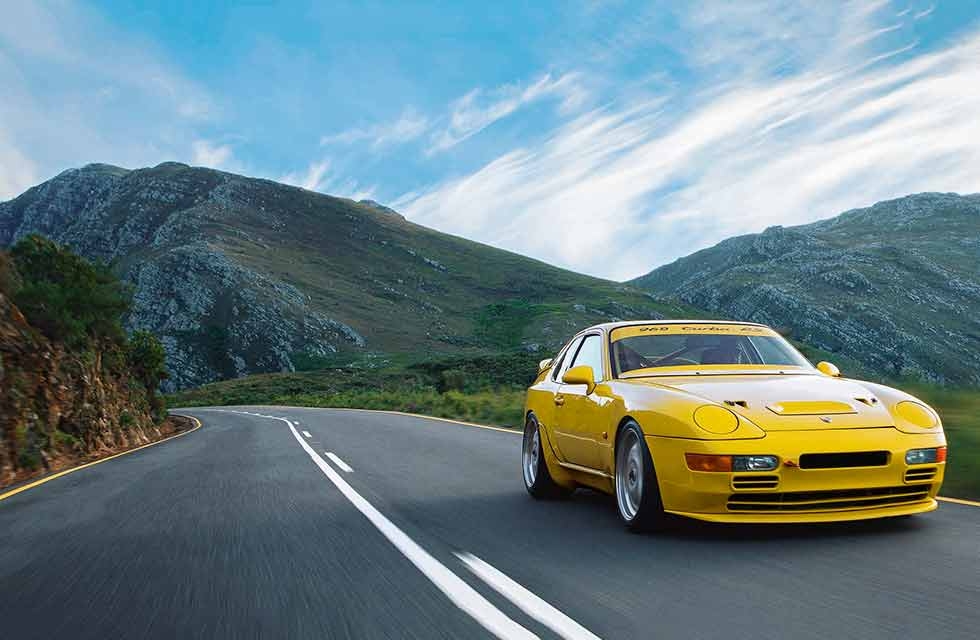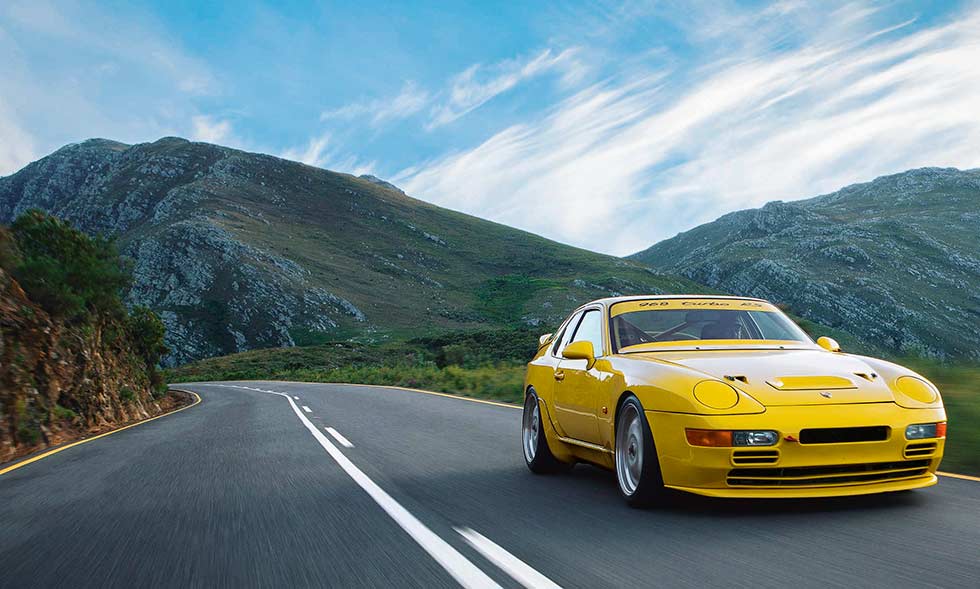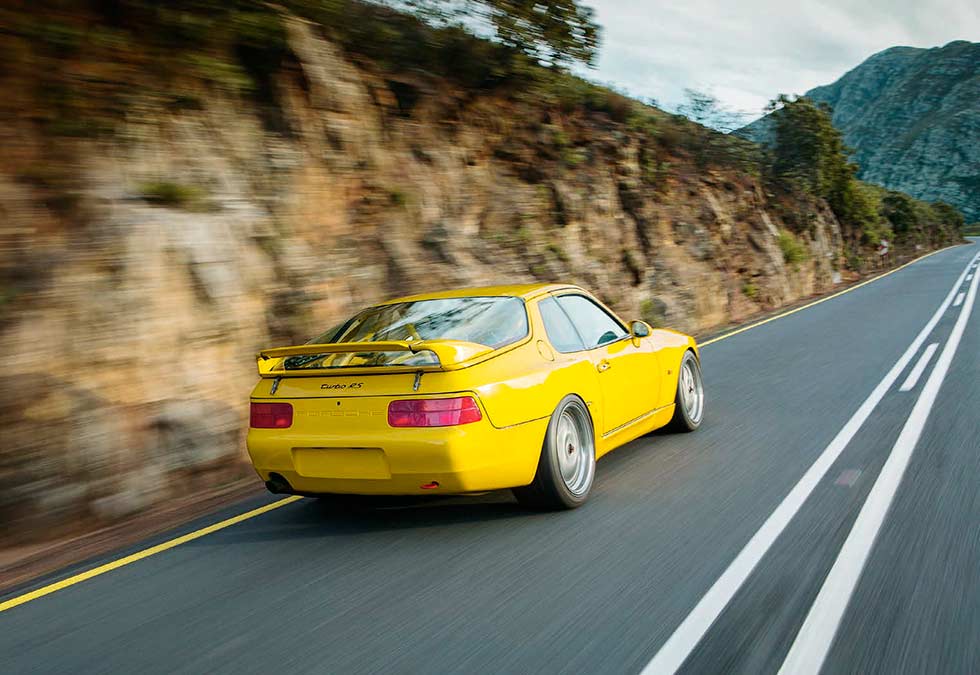
Think of an RS and you immediately consider it the domain of the 911, but just once Porsche applied its RennSport philosophy to a car that wasn’t rear-engined. Story: Wilhelm Lutjeharms. Photography: Charles Russell.
Special Reserve
1993 Porsche 968 Turbo RS Porsches don’t come much rarer than this, the legendary 968 Turbo RS. We track down this special car in the hills of South Africa.
Porsche’s RS products have grabbed headlines and the attention of motoring enthusiasts since the original’s inception in 1973. In the past decade, collectors and owners of these machines have enjoyed a spectacular gain in the value of their cars. Rightly so, these are special Porsches from both a mechanical and driving point of view and, in most cases, also in terms of the production numbers; since the original 911 2.7 Carrera RS only the 964 RS was produced in higher volumes.

But the RS moniker hasn’t always been used to identify a 911 with racing pedigree, for there is one exception to the rule that few are aware of. During Porsche’s troubled times in the early 1990s, the 968 was delivered to market to help keep the company afloat. But even this ‘new’ model struggled despite the likes of the Club Sport, Turbo and Turbo S. The latter, of which only ten were produced in 1993, was the basis for one of the rarest cars in Porsche’s history, the 968 Turbo RS. As is the case with several low-volume, driver-focused cars, the idea came about when a few engineers started developing an itch, followed by that inevitable: what if?

To get the full story behind this cloudy piece of Porsche history, I had to email Porsche and then the individual contacts that were suggested with each successive reply. Finally I was given the number of Gerd Schmid, a retired Porsche employee. However, Schmid isn’t just any ex- Porsche employee, he’s one of those guys with whom you want to share an afternoon and a few pilsners with. As the head of the customer motorsport department, he had an illustrious career, being part of some of the most successful historical racers. He was, to name a few, part of the team responsible for the 3.0 RSR, 934 and 935. In 1983, he started the customer programme for Group C followed by a similar setup for those in the fortunate position to find themselves with a GT1 in their race team’s workshop. In the years leading up to his retirement, he was instrumental in launching the Carrera Cup in several countries and regions, including the Middle East, Asia, Japan and Australia. However, in the early 1990s, he headed up the 968 Turbo S and Turbo RS projects, and this is what he had to say about the latter: “We built three cars according to the regulations for the ADAC GT Cup at the time. There was a red, white and black example. Each of these cars were fitted with a 41-litre fuel cell for this 1000km race.”
A fourth Turbo RS was also built for a customer. This was built with advanced modifications as this Speed yellow example was destined for racing in South Africa, outside the ADAC restricted limitations. The mechanical upgrades were a combination of the best parts Porsche had access to at the time. “The intake system and upper part of the engine was from a 944 Turbo while the lower part of the engine and the crankcase was from a 968. There were also a few parts especially designed for these cars. It is important to remember that these cars were sold by the racing department, and not the sales division,” Schmid adds. This is the most significant fact when it comes to the history of this specific Speed yellow Turbo RS.
“The real Turbo RS was never homologated for the street. However, the Speed yellow example was one of the first of two 968 Turbo S cars converted to RS specification. There was a lot of design and bodywork development at the time with the tuning company TechArt. Porsche later homologated these modifications for the street cars.
“It was this single car that Porsche, TechArt and its first owner modified together. The other cars were standard 968 Turbo S models and then the three 968 Turbo RS race cars.”
For all their uniqueness, these RS cars were short-lived. As Schmid pointed out, the car was extremely expensive at the time – a Turbo S cost DM175,000, nearly DM100,000 more than a 968 Club Sport; and secondly, the idea was to sell only a few. However, it was Schmid’s final remark that possibly hits the nail on the head: “You must remember that during the early 1990s, when this project was born, Porsche was financially unstable. During this time we created several special production cars, otherwise we would probably never have created a Turbo S or Turbo RS. Everybody at Porsche loved the 911, but not the 968. But, actually the 968 Turbo S, as tuned by the factory, was much faster than the 993 911 Turbo.”
This car’s first owner, who was invited to the factory to see the car in production, immediately suggested a few tweaks. He wanted a wind deflector fitted at the bottom of the windscreen (hiding the windscreen wipers), which helped with the aerodynamic airflow over the car. Apart from the two standard Naca ducts in the bonnet, a new bonnet was developed with a special airflow duct to aid cooling for the radiator and limit heat building up in the engine bay.
He also suggested a water-spray system be installed for the intercooler (which is operated from the cabin). Later the headlights were removed and the lower lights were upgraded to offer dipped and high beam functions. Then there were those iconic, standard, three-piece Speedline wheels.
As this was not an official racing Turbo RS with the air restrictor, and with the additional modifications in place, it is safe to assume that the engine now produces in excess of the 350hp of the Turbo RS. Bear in mind that the standard Turbo S delivered 305hp and 369lb ft and weighed just 1300kg.
The car is now part of the Apex Collection, which is housed in a Porsche museum at Weltevreden Estate outside Stellenbosch in South Africa. The car demands attention in a different way to a 964 RS or 993 RS. In a world that has gone 911-mad, the low stance of this race-ready, extremely rare 968 is surely more special than any 911 of its era. It is pure race car (it weights nearly 100kg less than the Turbo S) from every angle. The best view is undoubtedly when you open the rear hatch and see the fuel tank, pipework and thick crossmembers of the full road cage.
Entry is slightly trickier than most Porsche RS models with one of the roll bars running from the roof directly into the footwell, leaving the opening cut in two. However, I paid close attention when its owner manoeuvred himself into the driver’s seat; you simply hold on to the roof and the top of the roll bar, lift your feet into the footwell and lean on the crossmember and slide into the bucket seat. Get it right, and it makes for a rapid and efficient ingress.
Once behind the wheel you feel as if you don’t need the four-point harness – the seat hugs you from your thighs right up to your shoulders. With the harness clicked in, I take a moment to shift the gear lever through all the gates, impressed with the slick and solid feel. It would pay dividends later on.
There are very few civilian comforts in the interior such as the ventilation system, indicators and lights switches. To the left, above the steering wheel is a ventilation pipe that channels fresh air into the cabin. Look in your rear view mirror and your vision is filled with yellow metal bars. I chuckled as the photographer opened the glove compartment; it doesn’t even have space for a pair of racing gloves, as the roll cage runs through there too.
Pulling away from standstill isn’t this RS’ forte. To master it you do need to give it more throttle than initially thought, and then off it goes. The immediate surprise is how tractable the engine is. Not wishing to disturb everyone before sunrise on this cold winter morning in RSA I short-shift between 2500 and 3000rpm, the 968 taking it in its stride. No tantrums, hissy fits or coughs and splutters. Pure Porsche efficiency still evident today in a 21-year-old car.
Stuttgart’s engineers are regular visitors to the Franschhoek mountain pass for development work, contributor Richard Meaden was here in 2011 riding shotgun in the passenger seat with Porsche’s engineers in the company’s 991 test mules. There are good reasons for Porsche to spent much of its development time here. First, the surface is near-billiard smooth; second, it offers two hairpins with a combination of faster corners; and then there is the perfect landscape – although I doubt the latter was on the test driver’s agenda.
Away from resting locals I slowly squeeze the Turbo’s throttle deeper into the footwell and the engine gradually gains momentum as the crank speed climbs to 3000rpm, its big capacity cylinders doing their job as the big, single turbo begins to wake… and then it clearly hits boost, the needle swings with a level of confidence I didn’t expect to 6000rpm, at which point the gear indicator lights up. Another gear and the turbo onslaught continues. This car is fast, a point made in a very simple way.
The temperature is around ten degrees Celsius and the tyres simply spin in the first two gears, but as air and surface temperature increases so to do the grip levels. With a new level of confidence I go again. Approaching the first set of corners it’s not the feedback from the steering that impresses the most, but what you feel from the entire chassis through the seat. A preconceived notion prepared me for some extreme tramlining (even on this smooth surface), but the car rides camber changes with relative ease and any directional changes are calmly controlled.
The roll-cage, stiffer and lower suspension (20mm lower than a 968 Clubsport) and race seats result in a car that feels like a track-honed tool. You can hear every little stone thrown into the wheelarch, every single sand patch – it’s similar to running wide on the track in a GT3 Cup car and wincing at the aural attack that goes on underneath the car.
Push on, and the gearbox comes to the party. It offers a short throw: once you are done with first to second, simply push the lever out of second, let the spring bring it in line with third gear and push it forward to select the next ratio. During the 1990s (and even today) people raved about Honda NSX’s smooth and mechanical gearbox, but this Turbo RS’s ‘box is right up there with the best; and as a special touch, the car was delivered with a 962 gearshift knob. Now that’s cool.
“Actually the 968 Turbo S, as tuned by the factory, was much faster than the 911 Turbo 993”
As this is a classic front-engined, rear-wheel drive setup, learning to push it harder and harder is easier than a 911 of the same vintage and representative specification. The weight transfer is more predictable than the immediacy of the transition of a 911 when the rear axle loses traction. Fortunately the limited-slip differential (offering up to 75 per cent lock) further helps to put all that torque down to the road.
Along with the 924 Carrera GT, the 968 Turbo RS is undoubtedly the most sought-after of Porsche’s front-engined cars. During Gooding & Company’s Amelia Island auction in 2012, a Turbo RS was sold for an impressive $346,500; one of the highest, if not the highest ever bid for a front-engined Porsche. Had the number 58, 968 Turbo RS from Seikel Motorsport was not involved in a crash at the 1994 Le Mans endurance race, this auction price would have surely been higher.
When I asked Schmid about the speed of the 968 Turbo RS, his reply summed up the car and its sad demise: “Because it was faster than a 911 Turbo, the board decided to stop any further work on the 968 Turbo S/RS project. The technical side of this car was really impressive, but the pricing was simply too high.”
Isn’t this the same as Porsche’s perfectly balanced, mid-engined Cayman? Although there might be a long-awaited Cayman GT4 on the way, it is nearly ten years after the launch of the original Cayman and only now Porsche is starting to develop its mid-engined marvel to its full potential.
No matter which way you look at it, the 968 Turbo RS deserves its famous moniker on its tail just as much as any 911 that has gone before or after. Despite the SUVs and saloon cars it builds today Porsche has always reserved the RS name for its very special road cars, and the 968 Turbo RS is certainly that.






